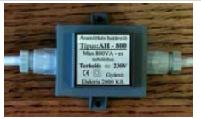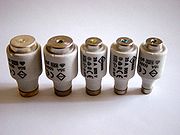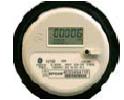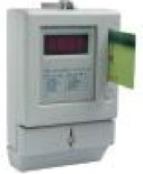Difference between revisions of "Metering and Billing Systems"
From energypedia
***** (***** | *****) |
***** (***** | *****) |
||
| Line 45: | Line 45: | ||
<br> | <br> | ||
| − | = Current limiter / Fuses<br> = | + | = Current limiter / Fuses<br> = |
| − | |||
| − | |||
{| width="200" cellspacing="1" cellpadding="1" border="0" align="right" | {| width="200" cellspacing="1" cellpadding="1" border="0" align="right" | ||
|- | |- | ||
| − | | [[Image:Current limiter 1.jpg | + | | [[Image:Current limiter 1.jpg|Current limiter / fuse; price may be < 5 USD]] |
| − | | [[Image:Current limiter 2.jpg| | + | | [[Image:Current limiter 2.jpg|100x98px|fault current breaker]] |
| + | |- | ||
| + | | [[Image:100px-Electrical Fuse (aka).jpg|45x120px]] | ||
| + | | [[Image:180px-DIAZED fuses.jpg]] | ||
|} | |} | ||
| + | |||
| + | <u>Advantages</u> | ||
*simultaneously protecting against overcurrent (actual purpose | *simultaneously protecting against overcurrent (actual purpose | ||
| − | *cheap if simple versions<br> | + | *cheap if simple versions<br> |
*no meter reading required => indirect power flat rate according to max. amperage | *no meter reading required => indirect power flat rate according to max. amperage | ||
<u>Disadvantages</u> | <u>Disadvantages</u> | ||
| − | *accuracy of cicuit breakers as load limiter fluctuates (even items from one batch have different trigger levels)<br>=> neigbours with same connections may be able to use different wattage<br> | + | *accuracy of cicuit breakers as load limiter fluctuates (even items from one batch have different trigger levels)<br>=> neigbours with same connections may be able to use different wattage<br> |
| − | *fault current breaker are rarely available in < 1 Ampere range (1 A / 220 V => 220 Watt)<br> | + | *fault current breaker are rarely available in < 1 Ampere range (1 A / 220 V => 220 Watt)<br> |
| − | *time of usage not considered; less fair | + | *time of usage not considered; less fair |
| − | *melting fuses | + | *melting fuses are available and cheap but very easy to bridge (also temporarily) => encouage missuse<br> |
| − | |||
| − | |||
| − | |||
| − | <br> | ||
| − | <br> | + | <br> <br> |
| − | [[Category: | + | [[Category:Load limiter]] |
| − | [[Category: | + | [[Category:Rural electrification]] |
= Flat rate = | = Flat rate = | ||
Revision as of 11:48, 2 June 2010
Standard kWh meter
Advantages
- technique is "state of the art"
- billing is fair and transparent
- reading can be uncoupled from tariff collection
- allows amount and time related tariffs (demand steering)
Disadvantages
- high costs (metering device)
- especially at rural areas in dev. countries the investment cost for a meter unit are way out of range
- dis- and re-connection in case of late payment
Pre-paid system with coins or cards
Advantages
- fair and transparent
- no meter reading
- no overdue costs
- no costs for dis- and re-connection
- close to “ability to pay”-variations
- coins less expensive than cards
Disadvantages
- relatively high cost for metering device
- less forgery proof
- costs for re-collection of coins and selling system for coins/cards
Current limiter / Fuses

|

|

|
Advantages
- simultaneously protecting against overcurrent (actual purpose
- cheap if simple versions
- no meter reading required => indirect power flat rate according to max. amperage
Disadvantages
- accuracy of cicuit breakers as load limiter fluctuates (even items from one batch have different trigger levels)
=> neigbours with same connections may be able to use different wattage - fault current breaker are rarely available in < 1 Ampere range (1 A / 220 V => 220 Watt)
- time of usage not considered; less fair
- melting fuses are available and cheap but very easy to bridge (also temporarily) => encouage missuse
Flat rate
Advantages
- very cheap (no metering or delimiting device)
- especially in rural areas of Indonesia quite common and accepted
- can be combined with number of appliances or installed wattage (social control)
Disadvantages
- provokes waste of electricity, no incentive for saving
- no load control / demand steering possible (peaks)
- less fair
Experience form Nepal : Innovative Metering
⇒ Back to Solar Section ⇒ Back to Hydro Section






















